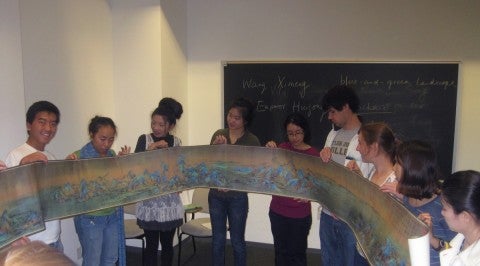Frequently asked questions from students regarding the fellowships and awards offered by the Department of Art History are listed below to help with the application process. Any additional questions can be directed to arthist@rice.edu.
- Can students apply to more than one museum fellowship?
-
Yes, students are welcome to apply for more than one or all the museum fellowships and are encouraged to apply again the next year should they be unsuccessful during their first attempt.
- When do fellowship applications open and close every year?
-
Applications typically open up in mid-February with deadline dates set around the beginning of March before spring break. Follow us on Instagram (@arthistoryrice), subscribe to our newsletter, or request to be added to our listserv in order to get the latest updates and announcements of application openings every year.
- Will the department accept applications after the deadline?
-
Applications will not be accepted and considered past the deadline date.
- When are students notified about the results of their fellowship and award applications?
-
Students who have successfully been selected as a fellow are notified by either the museum or department some time between the end of March-beginning of April.
- Are international students allowed to apply for these fellowships and awards?
-
Yes, international undergraduate and graduate students are allowed to apply for the fellowships and awards.
- Can a student receive a different fellowship if they have already received one in the past?
-
Yes, students are welcome to apply for a different fellowship even if they have received one in the past.
- Are there past student fellowship and award recipients who I can speak to about the programs and internships?
-
If you would like to get in touch with previous fellowship recipients to learn more about their experience, feel free to email arthist@rice.edu and their contact information will be provided to you.
- Do students have to be an art history major to apply for the fellowships?
-
No, the fellowships are open to all majors at Rice. Only the Distinction in Research and Creative Works Award requires the student to be an art history major and a senior.
- How competitive are the fellowships?
-
The fellowships are quite competitive as there is broad interest among students of different majors who apply and the department receives a number of applications for each fellowship. Museum curators for each fellowship review all the applications and make the final decision on the award recipient.
- What kind of projects and work do students focus on at the museums?
-
Each museum typically has their own unique project area that fellows will work on throughout the year. The project topics are subject to change every year depending on which museum departments need assistance and which exhibits need additional support and research. Specific project descriptions for each museum are usually released in the middle through end of February and can be found on the fellowship pages.
- Are there specific professors associated with the different museum fellowships?
-
There are no specific professors associated with the museum fellowships except for the Jameson Fellowship, which is led by Prof. Joseph Manca. Recipients of the other fellowships will be assigned a supervisor, typically a museum curator, who will provide training and guidance throughout the year.
- Do students have to be considering a career in museum work to receive a fellowship?
-
No, fellowship recipients in the past have backgrounds and interests ranging from the humanities like cinema, art history, and architecture to science and medical research.
- Is there transportation available for museums located farther away from campus?
-
Only the Jameson Fellowship provides help to partially cover the fellow's transportation costs to Bayou Bend during the year.
- What is an example of a proposed research project for the Lovett Travel Fellowship?
-
Research projects can be tied to a student's honor thesis, general interests and background, or plans for graduate studies. Examples of past proposed research projects include exploring how artistic renditions of the female body paralleled advancements in scientific knowledge, and another examining the interaction between art history and archaeology to highlight its influence on the narrative framework and identity of a country. A general research proposal should state specifics of the student's research topic including sites, cities, museums, or buildings the student plans to visit and see that will expand and enrich their research goal.
- How many people receive the Lovett Travel Fellowship each year?
-
There is no set number of students who receive the Lovett Travel Fellowship each year as awards and award amounts are dependent on department funding and the total number of applications received.
- Can graduating seniors apply for the Lovett Travel Fellowship?
-
Yes, graduating seniors can apply for the Lovett Travel Fellowship, but they are still required to submit a final research report to arthist@rice.edu one month after travel.
- Does the research trip for the Lovett Travel Fellowship have to be international?
-
No, research trips can be both domestic or international.
- Is there a maximum length of travel for the Lovett Fellowship?
-
There is no set length of travel required for the Lovett Fellowship though longer travel times typically require a bigger budget, and the department can not guarantee that the award amount will match the proposed travel budget.
- Aside from the museum and Lovett travel fellowships, are there other awards and fellowships students can apply to for study abroad assistance or to further their humanities research and education?
-
The School of Humanities also provides a number of awards and scholarships. A brief list can be found by scrolling to the bottom of the Undergraduate Awards page.

